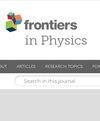Game-theory based truck platoon avoidance modes selection near the highway off-ramp in mixed traffic environment
IF 1.9
3区 物理与天体物理
Q2 PHYSICS, MULTIDISCIPLINARY
引用次数: 0
Abstract
Introduction: The rise of autonomous vehicles has brought about a transformative shift in transportation, witnessing the coexistence of human-driven and autonomous vehicles on highways in the United States, Europe, and China. This coexistence poses challenges to traffic operations, particularly in intricate scenarios like highway ramps. The interaction between autonomous truck platoons, displaying heightened maneuverability, and human-driven vehicles has emerged as a critical concern. Consequently, this research aims to propose and investigate three avoidance modes (overall, gap and cross) employed by truck platoons, evaluating their comprehensive impact on human-driven vehicles.Methods: Multiple scenarios are simulated utilizing the Simulation of Urban Mobility (SUMO) software, collecting data on three distinctive avoidance modes concerning Travel Time (TT) and Time to Collision (TTC). Employing principles of game theory, a comprehensive assessment is undertaken to evaluate the traffic efficiency and safety of each mode. Comparative analyses against a no-avoidance baseline are conducted, offering a holistic evaluation of each mode’s applicability across diverse scenarios.Results: The findings highlight the commendable performance of gap mode and overall mode in enhancing traffic efficiency, while cross mode excels in fortifying traffic safety. Overall, the gap mode emerges as the optimal choice among the three.Discussion: This study introduces a game-theoretic approach to managing human-machine mixed traffic flow, establishing a foundational framework for theoretical research in decision-making for emerging mixed traffic environments. It considers safety and efficiency perspectives across different types of traffic entities. The insights gained contribute to the evolving discourse on the integration of autonomous vehicles into existing traffic systems, addressing the intricate challenges posed by the coexistence of various vehicle types on highways.混合交通环境下高速公路匝道附近基于博弈论的卡车排避模式选择
引言自动驾驶汽车的兴起给交通带来了变革,在美国、欧洲和中国的高速公路上,人类驾驶汽车和自动驾驶汽车共存。这种共存给交通运营带来了挑战,尤其是在高速公路匝道等复杂场景中。自动驾驶卡车队显示出更高的机动性,与人类驾驶车辆之间的互动已成为一个关键问题。因此,本研究旨在提出并研究卡车排采用的三种避让模式(整体、间隙和交叉),评估它们对人类驾驶车辆的综合影响:方法:利用城市交通仿真(SUMO)软件模拟多种场景,收集三种不同避让模式在行驶时间(TT)和碰撞时间(TTC)方面的数据。利用博弈论原理,对每种模式的交通效率和安全性进行综合评估。与不避让基线进行比较分析,全面评估了每种模式在不同场景下的适用性:结果:研究结果表明,间隙模式和整体模式在提高交通效率方面的表现值得称赞,而交叉模式则在加强交通安全方面表现出色。总体而言,间隙模式是三种模式中的最佳选择:本研究引入了一种博弈论方法来管理人机混合交通流,为新兴混合交通环境的决策理论研究建立了一个基础框架。它从安全和效率的角度考虑了不同类型的交通实体。所获得的见解有助于将自动驾驶车辆融入现有交通系统的讨论,解决高速公路上各种类型车辆共存所带来的复杂挑战。
本文章由计算机程序翻译,如有差异,请以英文原文为准。
求助全文
约1分钟内获得全文
求助全文
来源期刊

Frontiers in Physics
Mathematics-Mathematical Physics
CiteScore
4.50
自引率
6.50%
发文量
1215
审稿时长
12 weeks
期刊介绍:
Frontiers in Physics publishes rigorously peer-reviewed research across the entire field, from experimental, to computational and theoretical physics. This multidisciplinary open-access journal is at the forefront of disseminating and communicating scientific knowledge and impactful discoveries to researchers, academics, engineers and the public worldwide.
 求助内容:
求助内容: 应助结果提醒方式:
应助结果提醒方式:


